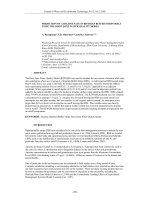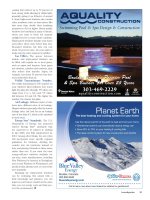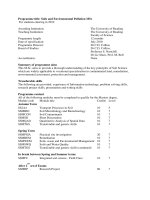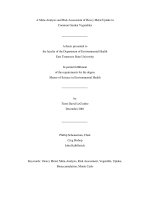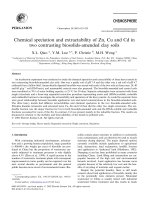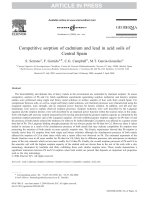mulching garden soils
Bạn đang xem bản rút gọn của tài liệu. Xem và tải ngay bản đầy đủ của tài liệu tại đây (486.62 KB, 4 trang )
Division of Agricultural Sciences and Natural Resources • Oklahoma State University
F-6005
Oklahoma Cooperative Extension Fact Sheets
are also available on our website at:
Steven H. Dobbs
Extension Consumer Horticulturist
Mulching Oklahoma garden soils may be one of the most
valuable cultural practices of gardening.
The use of organic materials for mulches can provide
many beneficial effects. These include: the control of annual
grasses and weeds; the elimination of the need for cultiva-
tion and the resulting damage to plant roots; the reduction of
moisture evaporation; the increase of water absorption and
retention; the decrease in runoff and soil erosion; and the
regulation of soil temperature. Other benefits are: cleaner, more
easily harvested crops; the reduction of fruit rot; and easier
movement through the garden during very wet periods.
Surface mulches will provide conditions for plant roots to
develop throughout the surface inches of the soil to absorb
water, nutrients, and oxygen. Luxuriant stem, leaf, flower, and
fruit growth follows the development of vigorous, extensive
root growth.
Most Oklahoma soils are high in mineral content, but low
in organic matter. The use of organic mulches in the home
garden and their incorporation into the soil at the close of
each gardening season provides an opportunity to increase
soil organic matter content, improve the physical condition of
the soil, and add some nutrients.
Mulching Materials
Many materials are available for mulching. The selection
of a particular material depends upon the cost, availability, the
season of the year, and the crop to be mulched.
Since one of the more important factors in successful
home gardening is the maintenance of an adequate level of
organic matter in the soil, this fact sheet will consider primarily
those materials that produce this result.
Suitable organic mulch materials should decompose
within a season and should not contain undesirable quantities
of viable seeds and harmful disease organisms or pests.
The material should be easily applied and remain in
place. It should not pack down and should be effective for at
least one season. Finally the mulch should be incorporated
with the soil for further decomposition. It is a good practice
to incorporate or compost garden refuse at the close of the
gardening season. This eliminates protective quarters for
insects to use in winter months.
Application of the Mulch
Growing Season Mulches
A mulch is frequently applied soon after the emergence
of the crop seedlings or following transplanting.
A delay in application of the mulch may be desirable if the
soil has not warmed sufficiently during the spring season.
In the event of excessive soil moisture, crop plant roots
may develop in the mulch layer where aeration is more favor-
able for root growth at that time.
The depth of a mulch layer will be influenced by the texture
of the mulch material since a primary objective is to prevent or
greatly reduce the germination and growth of annual weeds
and grasses.
The amount used might vary from 1 inch for sawdust,
peat moss, cotton seed hulls, ground corncobs, compost, or
similar density materials to 4 to 8 inches for straw, hay, corn
stalks, or other coarse materials.
Another factor in determining the amount and type of
mulch material used, is the need to provide protection to foli-
age, flowers, and fruits from soil-borne disease organisms that
could splash upon the plant. Also, to prevent the development
of fruit rots or leaf diseases.
Many of the more permanent plants of the yard and gar-
den may also be mulched to maintain a continuous soil cover
under and around the plants. This might include trees and
shrubs as well as hardy perennial flower, fruit, and vegetable
plants.
Some plants that benefit from summer mulching include:
tomato, pepper, eggplant, okra, green beans, cucumbers,
cantaloupe, squash, broccoli, cabbage, cauliflower, brus-
sel sprouts, sweet corn, asparagus, rhubarb, strawberries,
blackberries, dewberries, boysenberries, blueberries, and
tree fruits. Also, chrysanthemums, columbine, roses, azaleas,
asters, lilies, daylilies, perennial phlox, peonies, and many
kinds of annual flowers benefit.
Generally, the semi-arid plants and most wild flowers, when
grown in higher rainfall regions, should not be mulched.
Sweet potatoes do not benefit from summer mulching
except in very sandy soils and in dry seasons.
Winter Season Mulches
The principal reasons for winter mulching are to provide
more uniform soil moisture and to protect the plant from severe
temperatures during cold weather.
Winter mulches generally are applied around and over
the tops of low growing plants after the plants are in a dormant
or inactive stage of growth. This usually occurs in very late
December.
The amount of mulch applied is influenced by the severity
of winter cold, the amount of drying winds, and winter rainfall.
Mulching Garden Soils
Oklahoma Cooperative Extension Service
6005-3
6005-2
Often one will apply a cover, but not totally screen out plants
under the mulch. Loose mulch materials are more suitable
(straw, pine needles, loose hay).
As growth begins to develop, the young leaves will have
a very light green color due to the reduction of sunlight under
the mulch. Remove enough of the mulch to allow for normal
plant growth. With chrysanthemums this might require removal
of at least
3
/
4
of the mulch while with strawberries removal of
1
/
2
of the mulch might be adequate.
Often the cause of death in non-mulched plants is the
result of low temperature combined with excessive drying of
the soil.
How to Use Sawdust As a Mulch
Where sawdust is available it is commonly used as a
summer mulch. The material, preferably partially decomposed,
may be applied to a depth of 1 to 1
1
/
2
inches. This would
require about 5 bushels of sawdust for a 10 ft. x 10 ft. plot.
This amount of sawdust would, if dry, weigh approximately
50 pounds.
Before application, mix one pound of actual nitrogen per
5 bushels of sawdust to aid in further decomposition (1 lb.
actual nitrogen would be 3 Ibs. of ammonium nitrate or 5 Ibs.
of ammonium sulfate).
If no nitrogen were mixed with the sawdust some of the
nitrogen in the soil would be used for sawdust decomposition
after mulching. The result would be nitrogen starvation of the
mulched crop. Such plants would have yellowish-green foliage
and limited growth.
Strawberry runner plants may readily root down through
such a layer of sawdust while it provides excellent control of
most annual grasses and weeds. This amount of mulch would
perhaps be equal to adding between 6 to 10 inches of ad-
ditional irrigation water on non-mulched strawberry plants.
Using organic materials as mulches may cause an in-
crease in certain garden pests. The mulch provides an excellent
environment for sowbugs (or pillbugs) to grow. Some treatment
to reduce this pest may be needed. Recommendations for
this are provided in Fact Sheet F-7313 “Home Garden Insect
Control.”
Polyethylene Film and Other Sheet
Forms of Mulching
The use of air-tight sheets of plastic are less desirable as
mulching materials because of the lack of air movement into
the soil surface during periods of soil drying. However, this
may be offset by specific advantages of the practice. When
attempting to garden in an area infested with perennial weeds
or grasses the use of chemicals to control them may make
gardening in that area undesirable for several months.
An alternative weed control program is cultivation of the
area, and application of the needed fertilizers. Then cover the
surface with black polyethylene, set plants or plant seeds in the
soil through slits in the film. The result of this system will be the
destruction of the perennial grasses or weeds if the covering
remains over the soil throughout the growing season. There
may be small amounts of grass or weed growth through the
slit openings and these plants may require physical removal
at the close of the gardening season.
Also available to the home gardener are commercial
fabric weed barrier products. Weed barriers are manufactured
geotextile materials that provide a protective barrier primarily
for weed control in the landscape. Fabric weed barriers are
air and water permeable in most cases. However, on slopes
water tends to run along the fabric surface without readily
penetrating the material. In most cases gardeners use a
decorative mulch on top of the fabric barrier to restrain the
water from run-off and add aesthetic appeal. Nutsedge and
other similar weeds have been known to grow through the
fabric barrier.
The commercial vegetable industry has had degradable
plastic film available during the past few years to reduce their
dependency of cleanup and disposal. Such films are now avail-
able for home gardens. Photodegradable films disintegrate
under the exposure of ultraviolet light in a time-released man-
ner that usually lasts through one growing season. However,
remnants of the plastic can remain after a growing season.
Soil and foliage that may cover the plastic also blocks the
Ultra Violet light, thus preventing complete breakdown.
The use of aluminum foils or laminates may provide simi-
lar effects. Also, certain kinds of insects (leaf hopper, spider
mites, and aphids) may be repelled depending on the intensity
of reflected light to the under side of the plant foliage.
Table 1 provides information on mulch materials and some
of their characteristics.
Figure 1. Mid-Summer Temperature Differences between
Non-Mulched and Mulched Plots Measured 1 Inch Deep
in the Soil.
Figure 2. Mid-Summer Temperature Differences between
Non-Mulched and Mulched Plots Measured 3 Inches Deep
in the Soil.
Does the Mulch Will the Mulch Will the Mulch Available
Crust, Pack, Control Remain Effective Blaze (fire) Nutrients
Materials or Seal Grass and Weed for a Season Possibility Present Remarks
Peat Moss 2 2 2 2 4 May be blown or
moved by wind
or rain
Sawdust 2 2 2 2 5 -10-12 lbs/bushel
Bagasse 2 2 2 2 5 • May be blown
by wind
Cotton seed hulls 4 2 2 2 2 *Usually remains
where placed
Straw 1 2 2 5 3 • Presprout seed by
wetting bales
Leaves (b) 3 3 2 3 3 *May be blown by
wind
Cotton burrs 2 2 2 2 2 *Don’t use burrs
from chemically
defoliated plants
Lawn clippings 5 3 4 5 2 Compost - don’t use
fresh as a mulch
Hay - prairie 1 3 2 4 3 *Usually better if
chopped
Hay- legume 2 3 2 3 2 May become very
hot during early
decay
Compost 1 2 2 1 1 Also used as a row
cover in seed
planting
Wood chips 1 3 1 2 5 Excellent permanent
mulch
Bark
b
1 2 1 2 5 Excellent permanent
mulch
Wood shavings
b
1 2 1 5 5 *
Leaf mold 1 2 2 2 3 *
Gravel pebbles 3 4 1 1 5 Frequently used over
poly ethylene
Aluminum foil 5 1 1 1 5 May aid in insect
control
Black polyethylene 5 1 1 2 5 Will destroy perennial
grasses and weeds
Fabric weed barriers 5 1 1 4 5 Will not absorb water
readily on slopes
Pine Straw 4 2 2 1 4 Shred before
incorporating into
soil
Shredded newspaper 2 3 3 2 5 Wet to keep in place
Photodegradable film 5 1 2 2 5 Soil covered portions
will not decompose
(a) 1 = excellent, 5 = poor
(b) Black walnut sawdust, bark, and leaves is very toxic to some kinds of plants.
• Add 1 pound actual nitrogen per 50 pounds of dry organic matter to provide for decomposition.
Yard Trash - A Valuable Resource
Yard trash such as lawn clippings, leaves, pine needles
are an inexpensive and valuable resource for your vegetable
garden and landscape. Try recycling yard trash instead of
sending it to the landfill. Yard trash can be transported to your
compost pile (see Fact Sheet F-6014 “Making a Compost Pile”
and used later for mulch and/or soil conditioning.
Table 1. Some Mulch Materials and their Characteristics
a
6005-3
6005-2
Often one will apply a cover, but not totally screen out plants
under the mulch. Loose mulch materials are more suitable
(straw, pine needles, loose hay).
As growth begins to develop, the young leaves will have
a very light green color due to the reduction of sunlight under
the mulch. Remove enough of the mulch to allow for normal
plant growth. With chrysanthemums this might require removal
of at least
3
/
4
of the mulch while with strawberries removal of
1
/
2
of the mulch might be adequate.
Often the cause of death in non-mulched plants is the
result of low temperature combined with excessive drying of
the soil.
How to Use Sawdust As a Mulch
Where sawdust is available it is commonly used as a
summer mulch. The material, preferably partially decomposed,
may be applied to a depth of 1 to 1
1
/
2
inches. This would
require about 5 bushels of sawdust for a 10 ft. x 10 ft. plot.
This amount of sawdust would, if dry, weigh approximately
50 pounds.
Before application, mix one pound of actual nitrogen per
5 bushels of sawdust to aid in further decomposition (1 lb.
actual nitrogen would be 3 Ibs. of ammonium nitrate or 5 Ibs.
of ammonium sulfate).
If no nitrogen were mixed with the sawdust some of the
nitrogen in the soil would be used for sawdust decomposition
after mulching. The result would be nitrogen starvation of the
mulched crop. Such plants would have yellowish-green foliage
and limited growth.
Strawberry runner plants may readily root down through
such a layer of sawdust while it provides excellent control of
most annual grasses and weeds. This amount of mulch would
perhaps be equal to adding between 6 to 10 inches of ad-
ditional irrigation water on non-mulched strawberry plants.
Using organic materials as mulches may cause an in-
crease in certain garden pests. The mulch provides an excellent
environment for sowbugs (or pillbugs) to grow. Some treatment
to reduce this pest may be needed. Recommendations for
this are provided in Fact Sheet F-7313 “Home Garden Insect
Control.”
Polyethylene Film and Other Sheet
Forms of Mulching
The use of air-tight sheets of plastic are less desirable as
mulching materials because of the lack of air movement into
the soil surface during periods of soil drying. However, this
may be offset by specific advantages of the practice. When
attempting to garden in an area infested with perennial weeds
or grasses the use of chemicals to control them may make
gardening in that area undesirable for several months.
An alternative weed control program is cultivation of the
area, and application of the needed fertilizers. Then cover the
surface with black polyethylene, set plants or plant seeds in the
soil through slits in the film. The result of this system will be the
destruction of the perennial grasses or weeds if the covering
remains over the soil throughout the growing season. There
may be small amounts of grass or weed growth through the
slit openings and these plants may require physical removal
at the close of the gardening season.
Also available to the home gardener are commercial
fabric weed barrier products. Weed barriers are manufactured
geotextile materials that provide a protective barrier primarily
for weed control in the landscape. Fabric weed barriers are
air and water permeable in most cases. However, on slopes
water tends to run along the fabric surface without readily
penetrating the material. In most cases gardeners use a
decorative mulch on top of the fabric barrier to restrain the
water from run-off and add aesthetic appeal. Nutsedge and
other similar weeds have been known to grow through the
fabric barrier.
The commercial vegetable industry has had degradable
plastic film available during the past few years to reduce their
dependency of cleanup and disposal. Such films are now avail-
able for home gardens. Photodegradable films disintegrate
under the exposure of ultraviolet light in a time-released man-
ner that usually lasts through one growing season. However,
remnants of the plastic can remain after a growing season.
Soil and foliage that may cover the plastic also blocks the
Ultra Violet light, thus preventing complete breakdown.
The use of aluminum foils or laminates may provide simi-
lar effects. Also, certain kinds of insects (leaf hopper, spider
mites, and aphids) may be repelled depending on the intensity
of reflected light to the under side of the plant foliage.
Table 1 provides information on mulch materials and some
of their characteristics.
Figure 1. Mid-Summer Temperature Differences between
Non-Mulched and Mulched Plots Measured 1 Inch Deep
in the Soil.
Figure 2. Mid-Summer Temperature Differences between
Non-Mulched and Mulched Plots Measured 3 Inches Deep
in the Soil.
Does the Mulch Will the Mulch Will the Mulch Available
Crust, Pack, Control Remain Effective Blaze (fire) Nutrients
Materials or Seal Grass and Weed for a Season Possibility Present Remarks
Peat Moss 2 2 2 2 4 May be blown or
moved by wind
or rain
Sawdust 2 2 2 2 5 -10-12 lbs/bushel
Bagasse 2 2 2 2 5 • May be blown
by wind
Cotton seed hulls 4 2 2 2 2 *Usually remains
where placed
Straw 1 2 2 5 3 • Presprout seed by
wetting bales
Leaves (b) 3 3 2 3 3 *May be blown by
wind
Cotton burrs 2 2 2 2 2 *Don’t use burrs
from chemically
defoliated plants
Lawn clippings 5 3 4 5 2 Compost - don’t use
fresh as a mulch
Hay - prairie 1 3 2 4 3 *Usually better if
chopped
Hay- legume 2 3 2 3 2 May become very
hot during early
decay
Compost 1 2 2 1 1 Also used as a row
cover in seed
planting
Wood chips 1 3 1 2 5 Excellent permanent
mulch
Bark
b
1 2 1 2 5 Excellent permanent
mulch
Wood shavings
b
1 2 1 5 5 *
Leaf mold 1 2 2 2 3 *
Gravel pebbles 3 4 1 1 5 Frequently used over
poly ethylene
Aluminum foil 5 1 1 1 5 May aid in insect
control
Black polyethylene 5 1 1 2 5 Will destroy perennial
grasses and weeds
Fabric weed barriers 5 1 1 4 5 Will not absorb water
readily on slopes
Pine Straw 4 2 2 1 4 Shred before
incorporating into
soil
Shredded newspaper 2 3 3 2 5 Wet to keep in place
Photodegradable film 5 1 2 2 5 Soil covered portions
will not decompose
(a) 1 = excellent, 5 = poor
(b) Black walnut sawdust, bark, and leaves is very toxic to some kinds of plants.
• Add 1 pound actual nitrogen per 50 pounds of dry organic matter to provide for decomposition.
Yard Trash - A Valuable Resource
Yard trash such as lawn clippings, leaves, pine needles
are an inexpensive and valuable resource for your vegetable
garden and landscape. Try recycling yard trash instead of
sending it to the landfill. Yard trash can be transported to your
compost pile (see Fact Sheet F-6014 “Making a Compost Pile”
and used later for mulch and/or soil conditioning.
Table 1. Some Mulch Materials and their Characteristics
a
6005-4
Leaves, twigs, and other larger pieces should be
shredded to aid in speed of decomposition. A lawn mower or
mulching attachment can also be used to shred the leaves
during the fall season. Yard trash can be directly utilized
as mulch also, but if not fully decomposed, may compete
with nutrients for the plants. Supplemental nutrients may be
needed in this case.
Other gardening publications
OSU Extension Fact Sheets
F-1511 - “Trickle Irrigation for Lawns, Gardens, and Small
Orchards”
F-6004 - “Oklahoma Garden Planning Guide”
F-6007 - “Improving Garden Soil Fertility”
F-6009 - “Fall Gardening”
F-6012 - “Growing Tomatoes in the Home Garden”
F-6013- “Summer Care of the Home Vegetable Garden”
F-6014 - “Making a Compost Pile”
F-6032 - “Vegetable Varieties for the Home Garden”
F-7313 - ‘’Home Vegetable Garden Insect Pest Control”
F-7314 - “Control of Diseases and Nematodes in the Home
Garden”
F-7614 - “Soil Fumigation and Treatment to Control Soil-
Borne Diseases and Nematodes in Home
Gardens”
F-7625 - “Common Diseases of Tomatoes Part I. Diseases
Caused by Fungi.”
F-7626 - “Common Diseases of Tomatoes Part II. Diseases
Caused by Bacteria, Viruses, and Nematodes.”
F-7627 - “Common Diseases of Tomatoes Part III. Diseases
Not Caused by Pathogens.”
F-7635 - “Irish Potato Diseases: Prevention and Control.”
F-7638 - “Diseases of Cucurbits (Watermelons, Cucumbers,
Cantaloupes, Squash and Pumpkins)”
F-7640 - “Solar Heating (Solarization) of Soil in Garden Plots
for Control of Soil-Borne Plant Diseases”
F-7646 - “Diseases of Asparagus in Oklahoma”
This Fact Sheet is based on original material prepared by R. L. Campbell.
Oklahoma State University, in compliance with Title VI and VII of the Civil Rights Act of 1964, Executive Order 11246 as amended, Title IX of the Education Amendments of 1972, Americans
with Disabilities Act of 1990, and other federal laws and regulations, does not discriminate on the basis of race, color, national origin, gender, age, religion, disability, or status as a veteran in
any of its policies, practices, or procedures. This includes but is not limited to admissions, employment, financial aid, and educational services.
Issued in furtherance of Cooperative Extension work, acts of May 8 and June 30, 1914, in cooperation with the U.S. Department of Agriculture, Robert E. Whitson, Director of Cooperative
Extension Service, Oklahoma State University, Stillwater, Oklahoma. This publication is printed and issued by Oklahoma State University as authorized by the Vice President, Dean, and Director
of the Division of Agricultural Sciences and Natural Resources and has been prepared and distributed at a cost of 42 cents per copy. 0403
